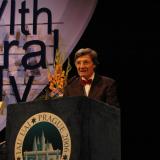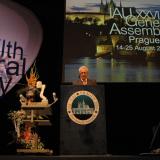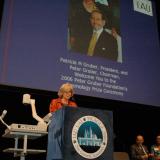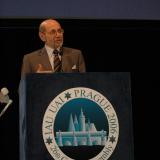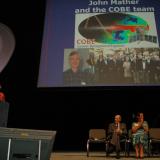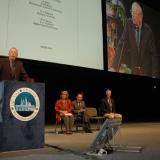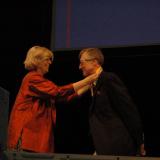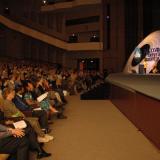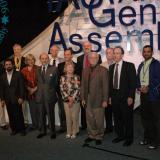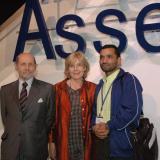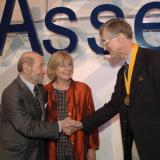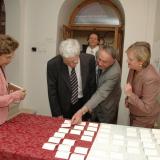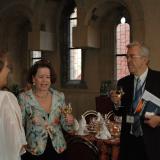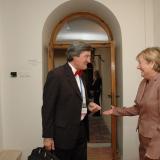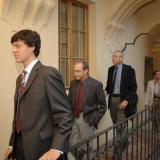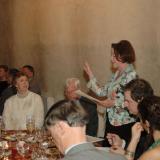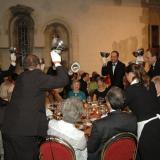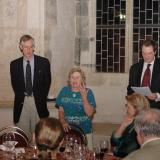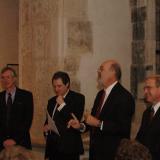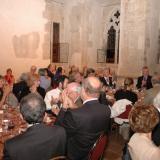2006 Gruber Cosmology Prize
After the launching of the Cosmic Background Explorer (COBE) by a Delta rocket in 1989, Dr. John Mather and the COBE Team were able to look far back in time to confirm that the universe was born in a hot Big Bang. The COBE, NASA's first dedicated cosmology mission, carried a Diffuse Infrared Background Experiment to search for cosmic infrared background radiation, a Differential Microwave Radiometer to map cosmic radiation sensitively, and a Far Infrared Absolute Spectrophotometer to compare the spectrum of the cosmic microwave background radiation with a precise blackbody. Each COBE instrument yielded a major cosmological discovery.
2006 Cosmology Prize Recipient
Laureate Profile
Dr. John Mather and the Cosmic Background Explorer (COBE) team received the 2006 Gruber Cosmology Prize for studies confirming that our universe was born in a hot Big Bang.
The instruments aboard NASA's Cosmic Background Explorer, launched in 1989, looked thirteen billion years back in time to the early universe.
COBE showed us that the young universe was hot, dense and almost uniform; that it contained weak fluctuations or lumps that grew into today's galaxies and stars; that these fluctuations were the result of a hot Big Bang; and that the universe is filled with diffuse radiation from previously unknown galaxies.
COBE was NASA's first dedicated cosmology mission, and the culmination of a fifteen-year dream for Mather, who initiated the project with a proposal to NASA in 1974.
NASA formed the science team in 1976, including members of two competing proposal teams. NASA's Goddard Space Flight Center built the COBE in Greenbelt, Maryland, U.S.
As COBE's scientific leader, Mather worked to keep a 1,500 strong project team focused on the science. There were many hurdles, including the Challenger Shuttle tragedy which sent the team back to the drawing board to redesign COBE for launch by a Delta rocket.
Now Mather still loves to look back in time. As chief scientist for the James Webb Space Telescope (JWST), he is hoping that it will see back to within just 200 million years of the Big Bang.
"We're explorers," he says. "We need to understand where we and our universe come from."
Mather received half the 2006 Gruber Prize. The balance was shared by the other eighteen members of the Science Working Group: Charles L. Bennett; Nancy W. Boggess; Edward S. Cheng; Eli Dwek; Samuel Gulkis; Michael G. Hauser; Michael A. Janssen; Thomas Kelsall; Philip M. Lubin; Stephan S. Meyer; S. Harvey Moseley; Thomas L. Murdock; Richard A. Shafer; Robert F. Silverberg; George F. Smoot; Rainer Weiss; David T. Wilkinson (deceased) and Edward L. Wright.
What's new for John Mather
In December 2006 the Nobel Prize for Physics was awarded to John Mather and George Smoot, "for their discovery of the blackbody form and anisotropy of the cosmic microwave background radiation."
In April 2007 Mather was named NASA's new chief scientist.
"COBE profoundly affected our understanding of cosmic evolution."
Peter Gruber, Chairman
The Peter and Patricia Gruber Foundation
Watch Videos
Citation
The 2006 Cosmology Prize of the Peter Gruber Foundation is proudly presented to John Mather and the COBE team for their ground-breaking studies of the spectrum and spatial structure of the relic radiation from the Big Bang.
Their instruments aboard NASA's Cosmic Background Explorer showed that the young universe was hot, dense and almost uniform, that it contained weak fluctuations which grew into all present-day structure and that these fluctuations could have been generated by physical processes only if the universe evolved differently at the earliest times than supposed by previous standard models.
With these results, the COBE team, led by John Mather, set cosmology's agenda for decades to come and profoundly affected our understanding of cosmic evolution.



